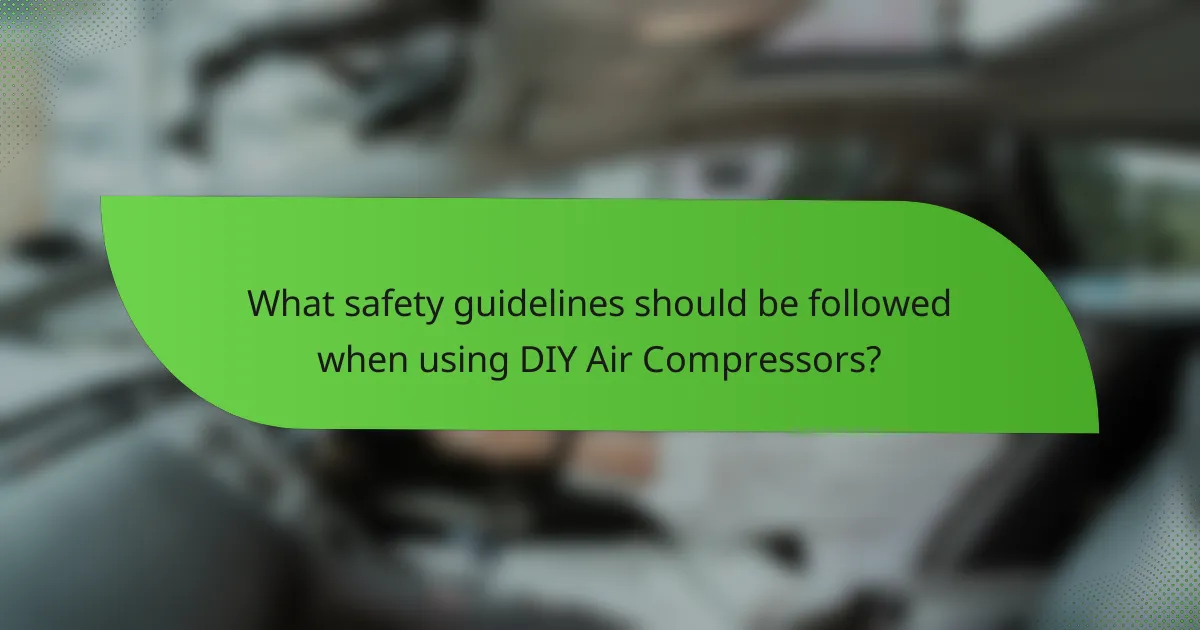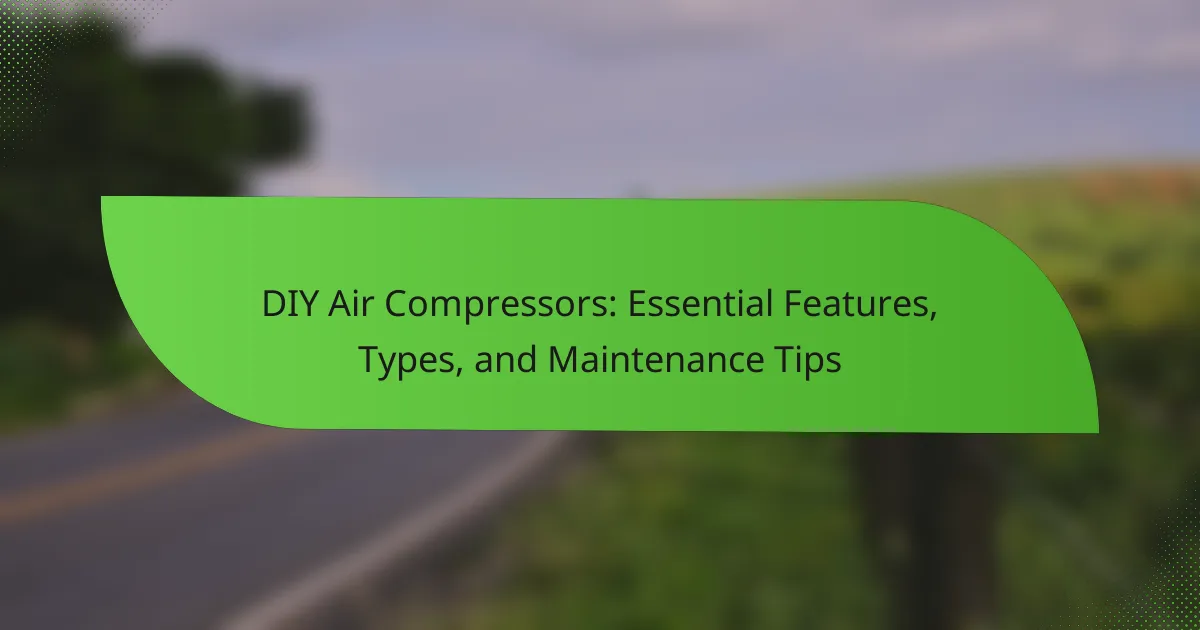DIY air compressors are devices designed for compressing air, utilized in various applications such as powering tools and inflating tires. They can be constructed from repurposed materials or purchased components, typically featuring a motor-driven pump that fills a storage tank with compressed air. The article covers common uses of DIY air compressors, essential accessories like air hoses and pressure regulators that enhance functionality, and important safety guidelines to follow during operation. Proper maintenance and safety precautions are emphasized to ensure effective and safe usage of these versatile devices.

What are DIY Air Compressors?
DIY air compressors are devices built for compressing air for various applications. They can be constructed from repurposed materials or purchased components. Commonly, they utilize a motor to drive a pump that compresses air into a storage tank. This stored air can then be used for powering tools, inflating tires, or other tasks requiring compressed air. DIY air compressors can vary significantly in size and capacity. Some models are designed for light tasks, while others can handle more demanding jobs. The versatility of DIY air compressors makes them popular among hobbyists and professionals alike.
How do DIY Air Compressors function?
DIY air compressors function by converting power into potential energy stored in pressurized air. They typically use an electric motor or a gas engine to drive a piston or diaphragm. This mechanism compresses air into a storage tank. As the air is compressed, its pressure increases, allowing it to be stored for later use. The compressor activates when the pressure in the tank drops below a certain level. This process continues until the desired pressure is reached. DIY air compressors are often used for inflating tires, powering pneumatic tools, and spray painting. Their efficiency can vary based on design, size, and power source.
What are the essential components of a DIY Air Compressor?
The essential components of a DIY air compressor include a motor, compressor pump, storage tank, pressure switch, and air regulator. The motor powers the compressor pump to compress air. The compressor pump is responsible for increasing air pressure. The storage tank holds the compressed air for later use. The pressure switch controls the air pressure in the tank. The air regulator adjusts the pressure for various applications. Each component plays a vital role in the functionality of the air compressor.
How do these components interact to create compressed air?
Compressed air is created through the interaction of various components in an air compressor system. The compressor draws in ambient air through an intake valve. This air is then compressed by a piston or rotary screw mechanism, which reduces its volume and increases its pressure. As the air is compressed, its temperature rises due to the laws of thermodynamics. The heated air is then cooled in a cooling system, often using an aftercooler. Finally, the compressed air is stored in a tank for later use. This process is fundamental for powering tools and equipment in DIY projects.
What are the common uses of DIY Air Compressors?
DIY air compressors are commonly used for various tasks. They are often employed for inflating tires, which is a quick and efficient method. Additionally, they are used for powering pneumatic tools like nail guns and spray guns. DIY enthusiasts utilize them for cleaning hard-to-reach areas with compressed air. They are also effective for painting projects, providing an even application of paint. Furthermore, air compressors are used for operating airbrushes in crafts and hobbies. Their versatility makes them valuable in workshops and home maintenance tasks.
How can DIY Air Compressors be utilized in home improvement projects?
DIY air compressors can be utilized in home improvement projects for various tasks. They power pneumatic tools like nail guns and staplers. This improves efficiency in tasks such as framing and roofing. Air compressors also assist in inflating items like tires and sports equipment. They can be used for painting projects with spray guns for a smooth finish. Additionally, they clean surfaces by providing a strong air blast. Their versatility makes them essential for many home improvement tasks. Proper use enhances productivity and quality of work in various projects.
What role do DIY Air Compressors play in automotive maintenance?
DIY air compressors are essential tools in automotive maintenance. They provide a reliable source of compressed air for various tasks. Common uses include inflating tires, powering pneumatic tools, and cleaning components. Proper tire inflation enhances fuel efficiency and extends tire life. Pneumatic tools, like impact wrenches, make tasks like changing tires faster and easier. Additionally, air compressors can blow away debris from engines and other parts. This cleanliness helps maintain vehicle performance. According to the U.S. Department of Energy, proper tire inflation can improve fuel economy by 3% to 4%. Thus, DIY air compressors significantly contribute to effective automotive maintenance.
How do DIY Air Compressors assist in crafting and hobbies?
DIY air compressors assist in crafting and hobbies by providing a versatile and efficient power source. They enable users to operate various tools such as spray guns, nail guns, and airbrushes. This capability enhances precision in tasks like painting and woodworking. Additionally, DIY air compressors can inflate items like balloons and sports equipment quickly. They also help in cleaning hard-to-reach areas with compressed air. The portability of DIY air compressors makes them accessible for various projects. Users can set up their compressors easily in different locations. Overall, they improve productivity and creativity in crafting and hobby activities.

What accessories enhance the functionality of DIY Air Compressors?
Accessories that enhance the functionality of DIY air compressors include air hoses, pressure regulators, and spray guns. Air hoses allow for the flexible transfer of compressed air to various tools. Pressure regulators help maintain consistent air pressure, ensuring optimal tool performance. Spray guns enable efficient application of paint or coatings, utilizing compressed air for a smooth finish. Additionally, tire inflators allow for easy inflation of tires, enhancing convenience. Quick-connect fittings facilitate fast tool changes, improving efficiency. Filters remove moisture and contaminants from the air supply, protecting tools and ensuring quality output. Each accessory contributes to a more versatile and effective use of DIY air compressors.
What are the essential accessories for DIY Air Compressors?
Essential accessories for DIY air compressors include air hoses, pressure regulators, and air filters. Air hoses connect the compressor to tools and should be durable and flexible. Pressure regulators help maintain consistent air pressure for tools. Air filters remove moisture and contaminants from the air supply. Additionally, quick-connect couplers allow for easy attachment and detachment of tools. Safety goggles and ear protection are also important for user safety during operation. These accessories enhance the functionality and efficiency of DIY air compressors.
How do air hoses improve the performance of DIY Air Compressors?
Air hoses enhance the performance of DIY air compressors by ensuring efficient airflow. They reduce pressure drop during air transmission. A high-quality air hose maintains consistent air pressure. This consistency is crucial for tools requiring stable airflow. Additionally, flexible hoses allow for better maneuverability. They can reach tight spaces that rigid pipes cannot. Moreover, hoses with appropriate diameter minimize air loss. This leads to improved tool efficiency and reduced energy consumption. Using the right air hose can significantly impact overall compressor effectiveness.
What types of air tools can be powered by DIY Air Compressors?
DIY air compressors can power various types of air tools. Common air tools include nail guns, impact wrenches, and spray guns. Nail guns use compressed air to drive nails into wood. Impact wrenches apply torque to fasteners with high efficiency. Spray guns utilize air pressure to atomize paint for smooth application. Other tools include air ratchets and air sanders. Air ratchets speed up the process of loosening and tightening bolts. Air sanders provide a smooth finish on surfaces. Each of these tools relies on the compressed air supplied by the DIY air compressor to function effectively.
How can additional accessories optimize the use of DIY Air Compressors?
Additional accessories can significantly optimize the use of DIY air compressors. Accessories like air hoses enhance mobility and reach during tasks. Quick-connect couplers allow for faster tool changes, improving efficiency. Pressure regulators help maintain consistent air pressure for sensitive tasks. Filters and moisture separators protect tools from contamination, extending their lifespan. Nail guns and spray guns leverage compressed air for precise applications. Tire inflators enable easy inflation of vehicle tires. Overall, these accessories maximize the functionality and versatility of DIY air compressors in various projects.
What are the benefits of using air filters and regulators?
Air filters and regulators improve air quality and control pressure in air compressors. They remove contaminants like dust, moisture, and oil from the air. This ensures cleaner air for tools and equipment, enhancing their lifespan. Regulators maintain consistent pressure, preventing damage to sensitive components. Consistent pressure also improves the efficiency of air tools. According to the Compressed Air and Gas Institute, using filters can reduce wear on machinery. This leads to lower maintenance costs and fewer repairs. Overall, air filters and regulators are essential for optimal performance and reliability in DIY air compressor setups.
How do pressure gauges contribute to safe operation?
Pressure gauges contribute to safe operation by providing real-time monitoring of system pressure. They help prevent over-pressurization, which can lead to equipment failure or accidents. By displaying accurate pressure readings, they enable users to make informed decisions. This ensures that the air compressor operates within its designed pressure limits. Consistent monitoring can also identify potential leaks or malfunctions early. According to OSHA guidelines, maintaining proper pressure levels is crucial for workplace safety. Regular calibration of pressure gauges further enhances their reliability and accuracy.

What safety guidelines should be followed when using DIY Air Compressors?
Always wear appropriate personal protective equipment (PPE) when using DIY air compressors. This includes safety goggles, gloves, and hearing protection. Ensure the compressor is placed on a stable surface to prevent tipping. Regularly inspect hoses and connections for leaks or damage. Use the compressor in a well-ventilated area to avoid inhaling harmful fumes. Do not exceed the manufacturer’s recommended pressure settings. Always drain the air tank after use to prevent rust and corrosion. Follow all manufacturer instructions for operation and maintenance.
What are the key safety practices for operating DIY Air Compressors?
Key safety practices for operating DIY air compressors include wearing appropriate personal protective equipment (PPE) such as safety goggles and ear protection. It is essential to inspect the air compressor for leaks or damage before use. Ensure that the compressor is placed on a stable, level surface to prevent tipping. Maintain a safe distance from flammable materials, as air compressors can generate heat. Always follow the manufacturer’s instructions regarding pressure settings and attachments. Use hoses and fittings rated for the compressor’s pressure to avoid failures. It is crucial to drain the moisture from the tank regularly to prevent rust and corrosion. Lastly, never exceed the maximum pressure rating of the compressor to ensure safe operation.
How can users prevent accidents while using DIY Air Compressors?
Users can prevent accidents while using DIY air compressors by following specific safety measures. Always wear appropriate personal protective equipment, such as safety goggles and ear protection. Ensure the compressor is placed on a stable surface to prevent tipping. Regularly check hoses and fittings for leaks or damage. Use the compressor in well-ventilated areas to avoid inhaling harmful fumes. Never exceed the manufacturer’s recommended pressure settings to avoid equipment failure. Keep bystanders at a safe distance while operating the compressor. Lastly, read and follow the manufacturer’s instructions for safe usage. These practices are essential for minimizing risks associated with air compressor operation.
What protective gear is recommended for DIY Air Compressor users?
Protective gear recommended for DIY air compressor users includes safety goggles, hearing protection, and gloves. Safety goggles protect the eyes from debris and dust. Hearing protection is necessary due to the high noise levels generated by air compressors. Gloves provide hand protection from sharp objects and potential chemical exposure. Additionally, a dust mask can be beneficial to prevent inhalation of airborne particles. Wearing steel-toed boots can also protect the feet from heavy equipment. These safety measures are essential for minimizing risks while using air compressors.
How can users troubleshoot common issues with DIY Air Compressors?
Users can troubleshoot common issues with DIY air compressors by following systematic steps. First, check the power supply to ensure the compressor is plugged in and the outlet is functional. If the compressor does not start, inspect the fuse or circuit breaker for any faults. Next, examine the air filter for clogs, as a dirty filter can impede airflow. Cleaning or replacing the filter often resolves performance issues.
If the compressor runs but does not build pressure, inspect the pressure switch and ensure it is functioning properly. Leaks in hoses or connections can also cause pressure loss. Applying soapy water to joints can help identify leaks. Additionally, check the oil level if the compressor is oil-lubricated, as low oil can affect operation.
For excessive noise or vibration, ensure the compressor is on a stable surface and check for loose parts. Tightening screws and bolts can often mitigate these issues. Lastly, consult the user manual for specific troubleshooting tips related to the model, as manufacturer guidelines provide tailored solutions.
What are the signs of an air leak, and how can it be fixed?
Signs of an air leak include hissing sounds, fluctuating pressure gauges, and visible condensation. Hissing sounds occur when air escapes from a damaged area. Fluctuating pressure gauges indicate inconsistent air pressure, suggesting a leak. Visible condensation can form around the leak site due to moisture in the air.
To fix an air leak, first, identify the source by inspecting hoses, fittings, and connections. Use soapy water to detect bubbles forming at the leak. Once identified, tighten loose fittings or replace damaged hoses. For small leaks, apply sealant or tape designed for air systems. Regular maintenance can prevent future leaks by ensuring all components are in good condition.
How can users address power and performance problems effectively?
Users can address power and performance problems effectively by regularly maintaining their air compressors. This includes checking and replacing air filters to ensure optimal airflow. Users should also inspect and tighten all connections to prevent air leaks. Monitoring oil levels in oil-lubricated compressors is crucial for smooth operation. Additionally, users should ensure that the compressor is not overloaded beyond its capacity. Operating the compressor within its specified pressure range helps maintain performance. Regularly draining moisture from the tank prevents rust and corrosion, which can impair performance. These maintenance steps are supported by manufacturers’ guidelines, emphasizing the importance of upkeep for efficiency and longevity.
What tips can enhance the overall experience with DIY Air Compressors?
To enhance the overall experience with DIY air compressors, ensure proper maintenance and regular checks. Clean the air filter frequently to maintain airflow efficiency. Use the correct oil type for oil-lubricated compressors to prevent damage. Check for leaks in hoses and fittings to maintain pressure. Choose the right size compressor for your projects to optimize performance. Ensure safety gear is worn during operation to prevent injuries. Store the compressor in a dry place to prevent rust and corrosion. Following these tips can significantly improve the functionality and longevity of your DIY air compressor.
DIY air compressors are versatile devices used for compressing air in various applications, from powering tools to inflating tires. This article covers their functionality, essential components, and common uses, highlighting how they assist in home improvement and automotive maintenance. Additionally, it discusses accessories that enhance their performance, safety guidelines for operation, and troubleshooting tips for common issues. By understanding these aspects, users can effectively utilize DIY air compressors while ensuring safe and efficient operation.



